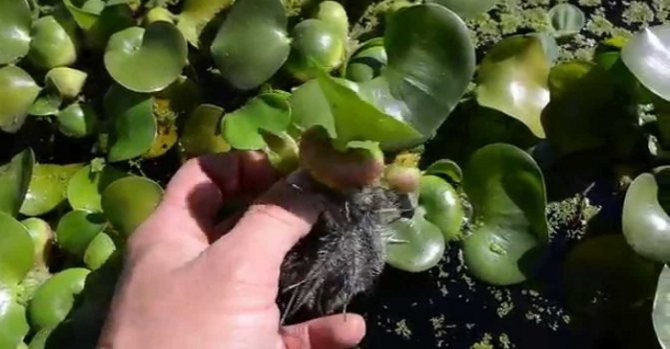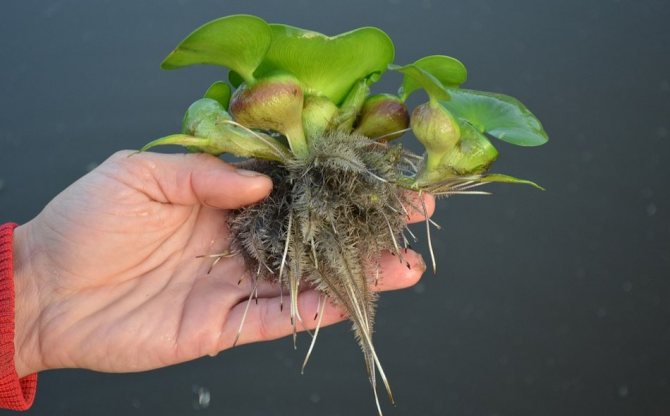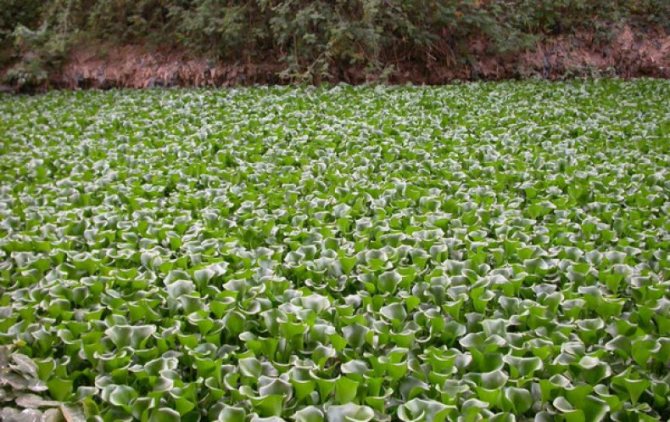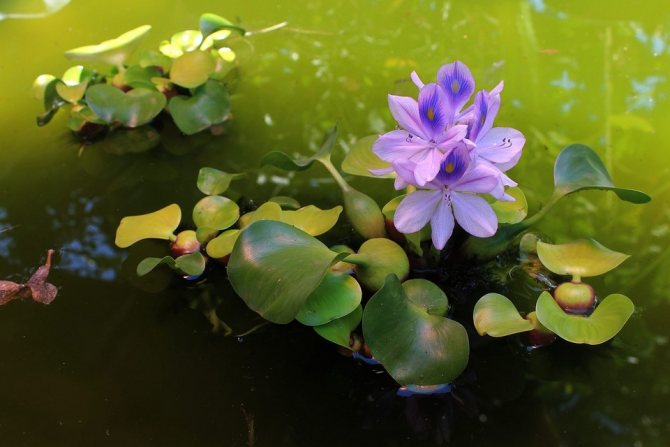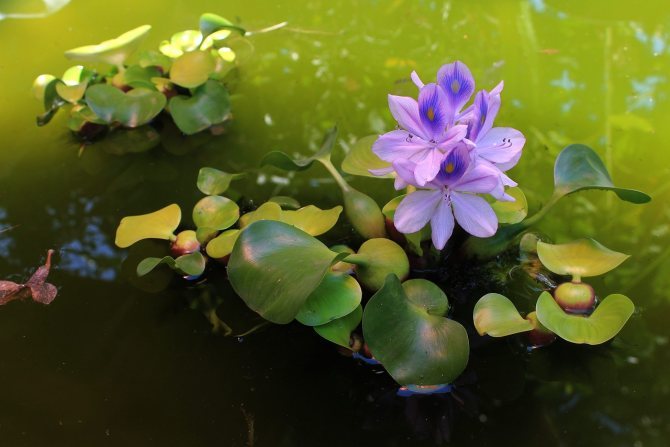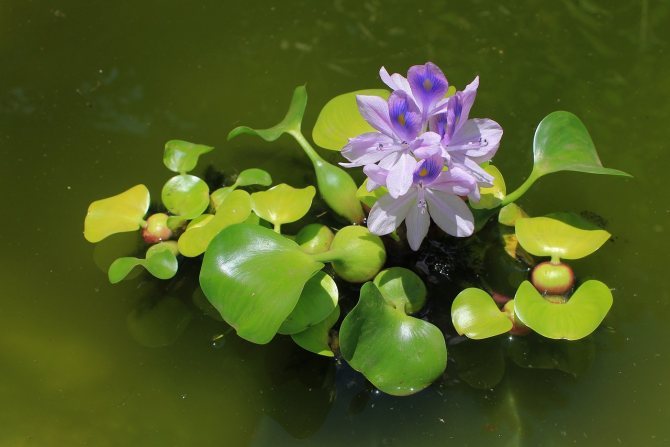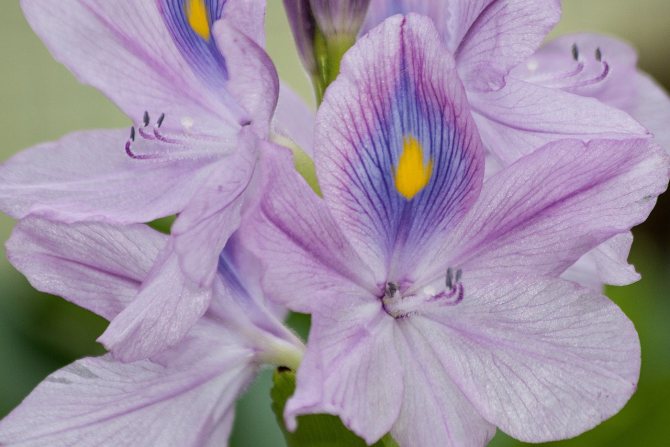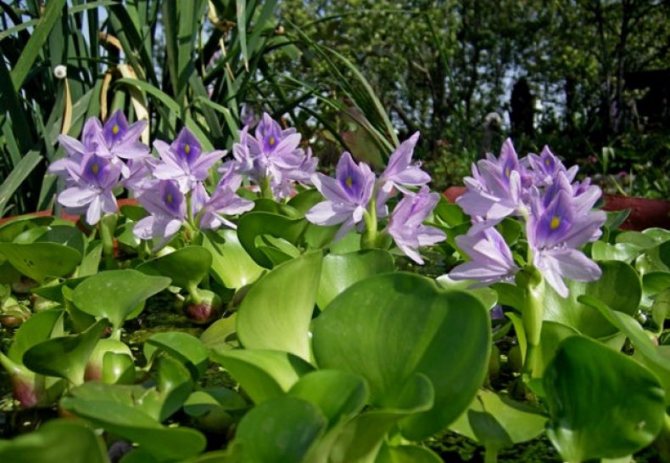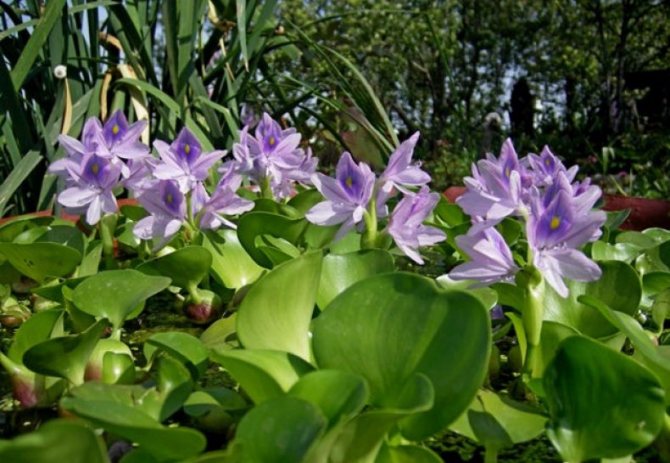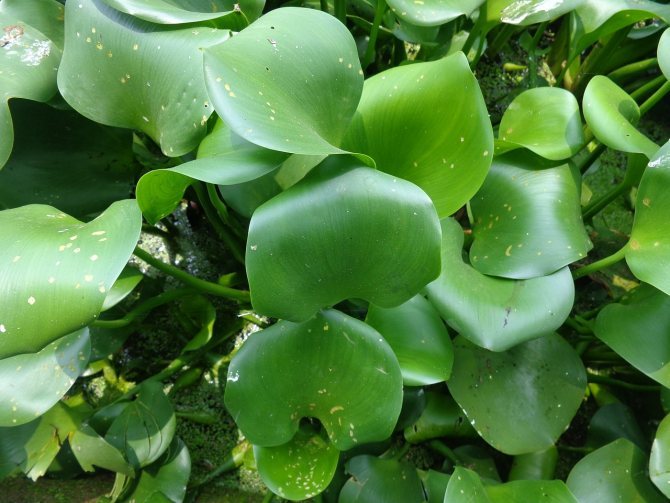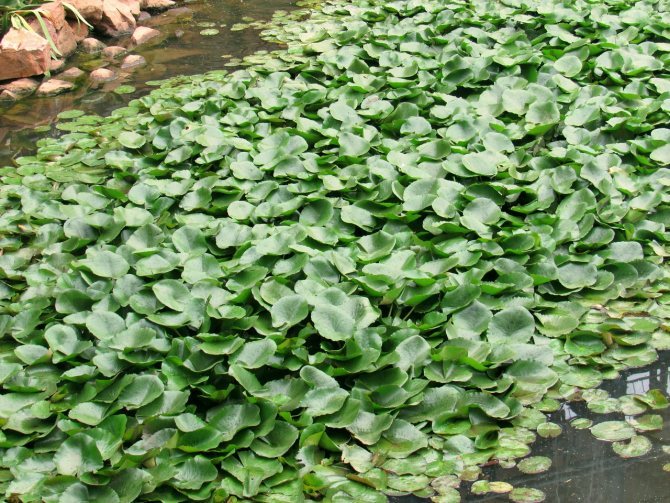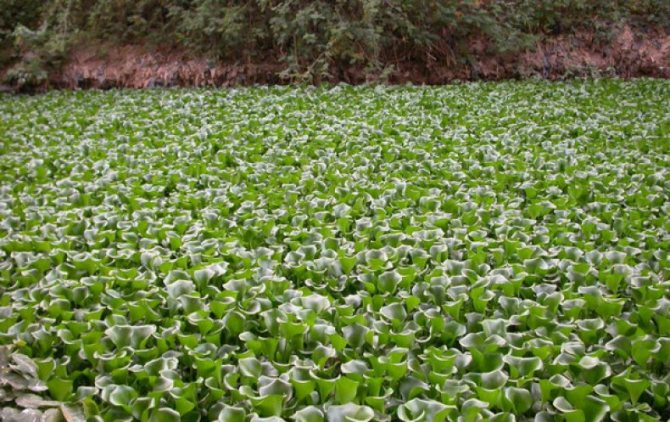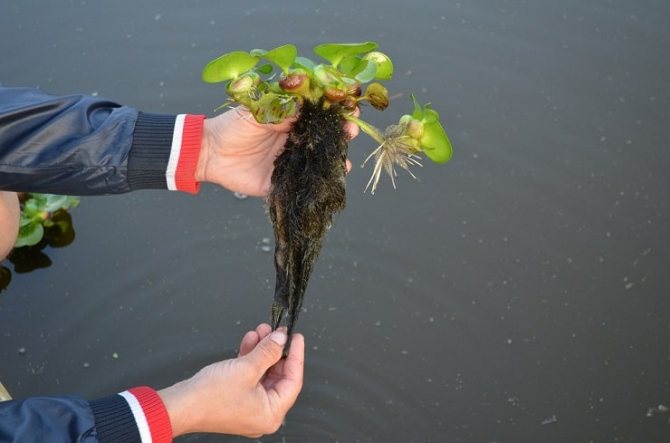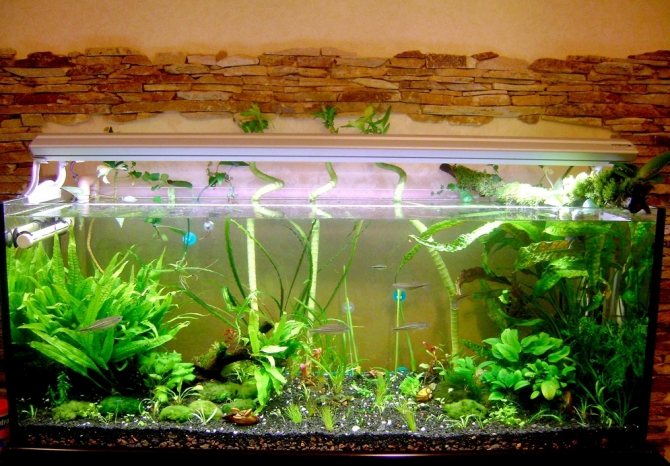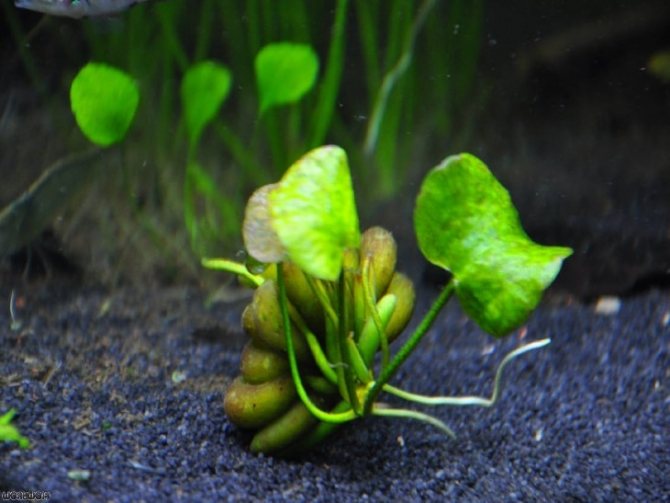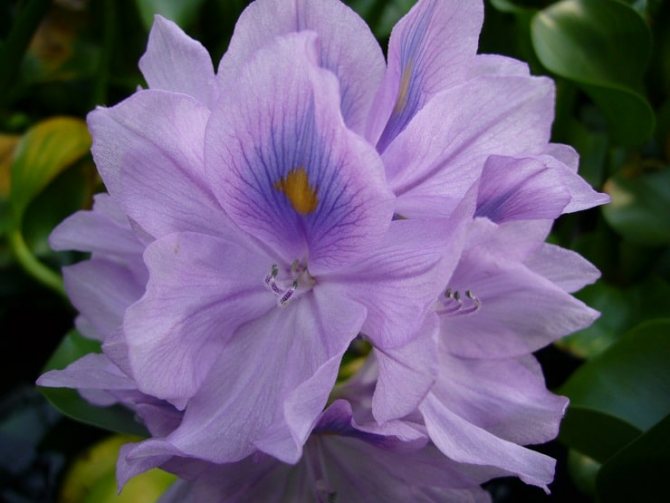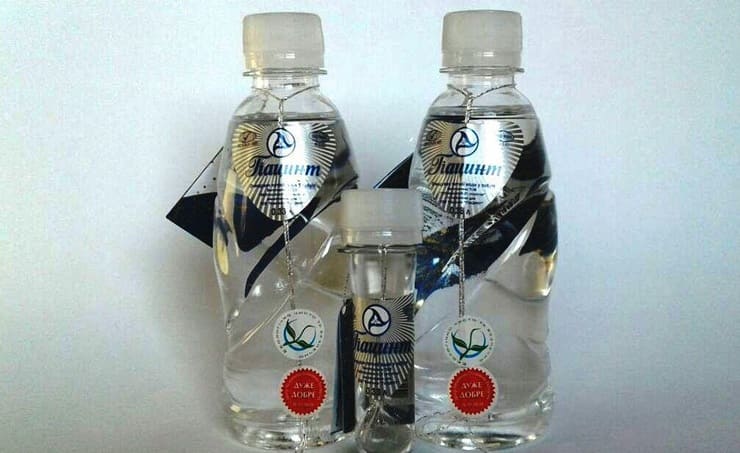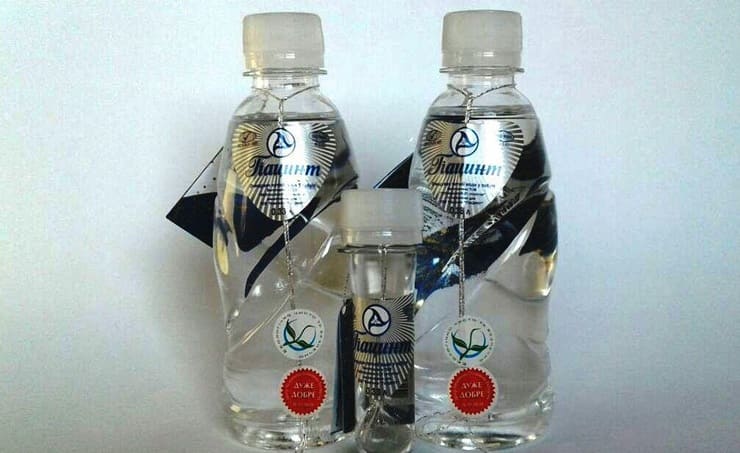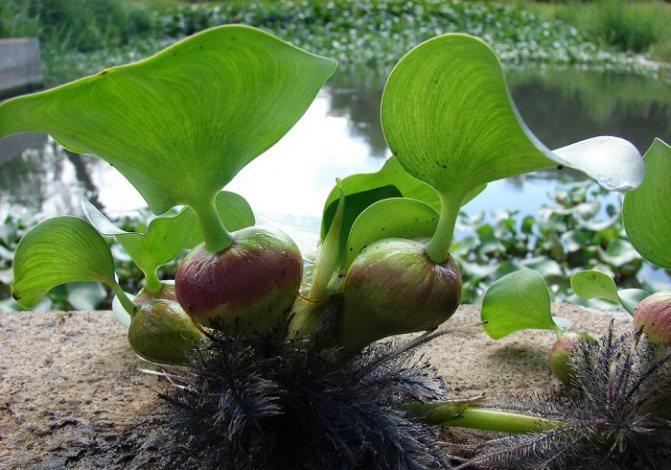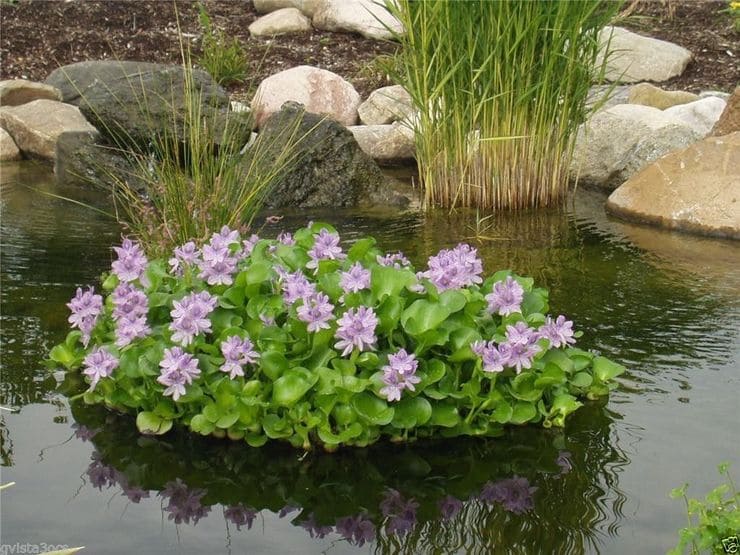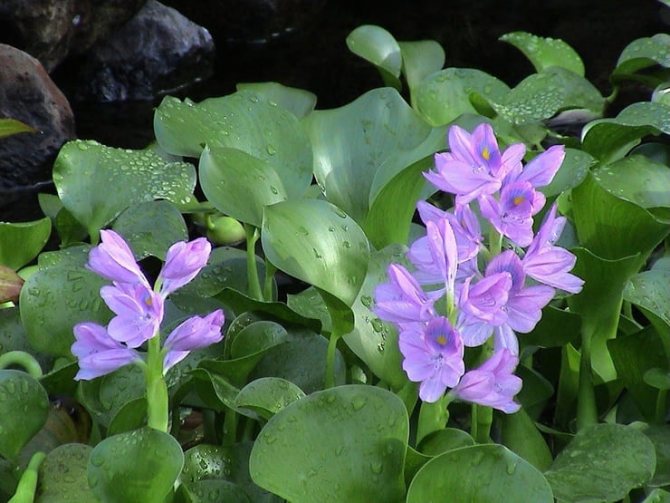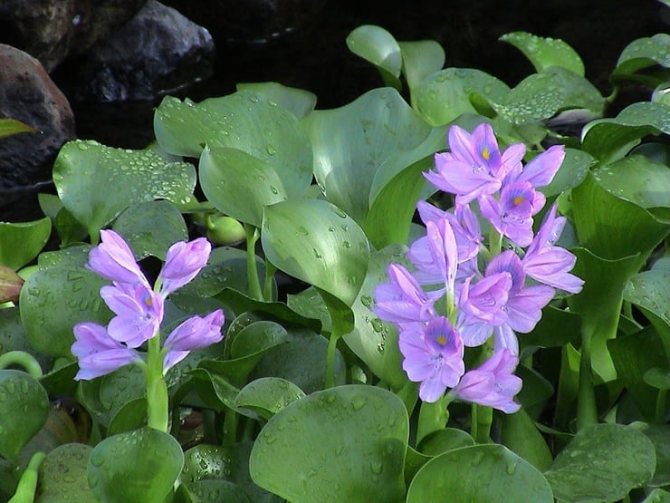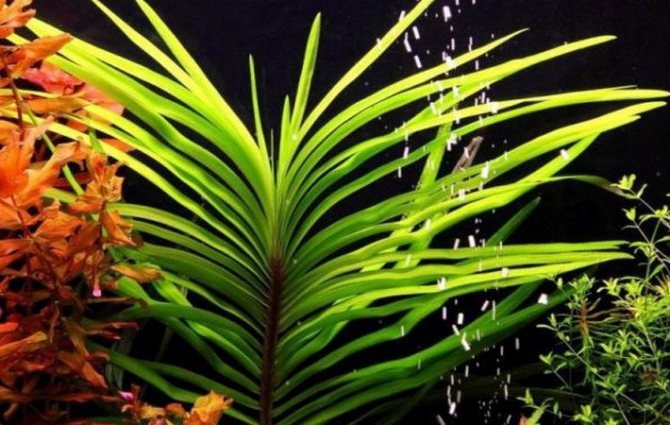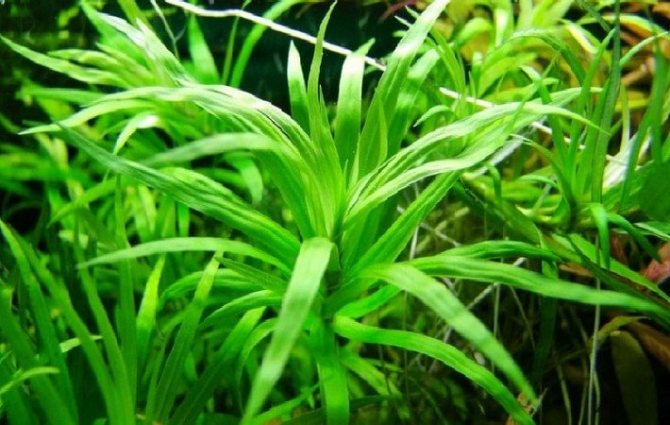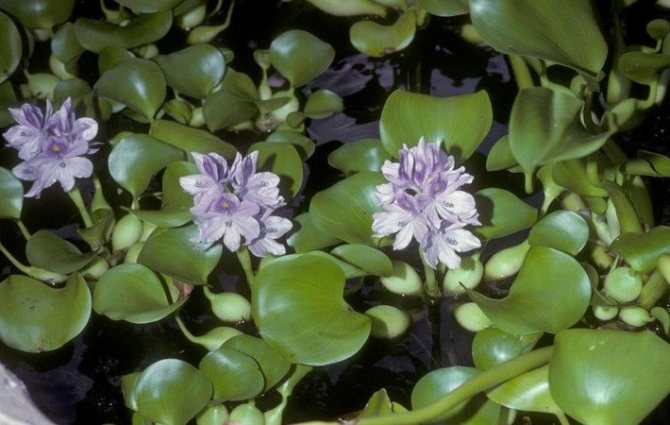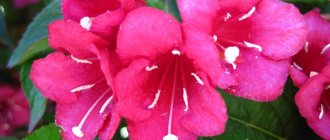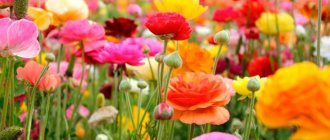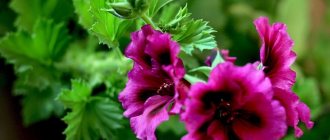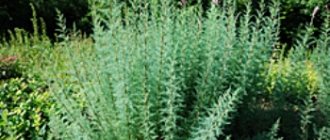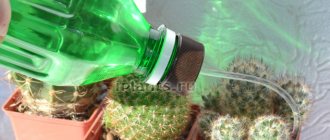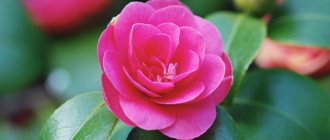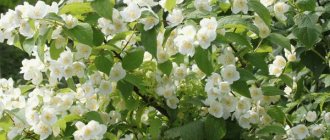Description
Water hyacinth or eichornia is a plant native to the tropical regions of South America. As the name implies, a flower grows in water. In nature, he settles in natural reservoirs - ponds, lakes, decorates the banks of ditches and swamps. Hyacinth needs stagnant, calm water, so you will not find it next to flowing water bodies.
External characteristic
Water hyacinth has a wonderful decorative appearance. The plant can boast of dense, bright green leaves of the petiole type: one leaf sometimes reaches 20 cm in diameter. The peculiarity of the foliage is that it, gathering in a dense rosette, keeps the plant on the surface of the water. An interesting detail: if a flower grows in restless water exposed to gusts of wind, its petioles will be thick. If the water is calm, without ripples, the petioles become long, graceful.
One stem produces about 10-15 buds - quite large and bright. The color of the petals can be of any shade from the pink-violet spectrum: sometimes pale pink, sometimes deep lilac. In addition to the beautiful appearance, the buds also emit a delicate aroma.
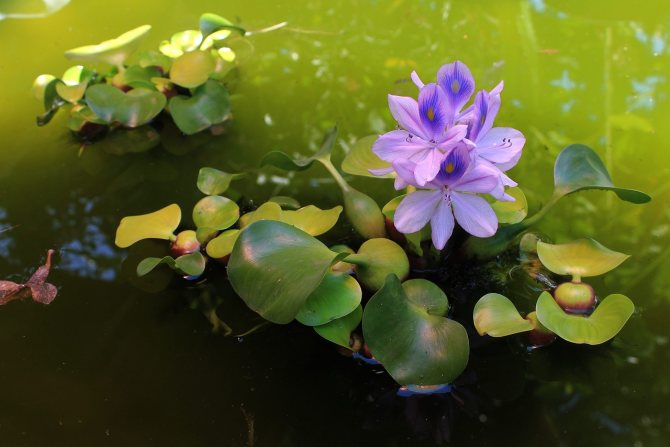
In our climate, eichornia blooms only in summer. The peduncle is located in the very middle of the leaf rosette: the bud opens slowly, gradually becoming more attractive and aromatic. The delicate color of the petals looks advantageous against the background of uniform green foliage (see photo).
One bud blooms for just a day, after which a seed capsule forms in its place. After ripening, the seeds fall into the water, where further independent reproduction of flowers takes place. But this is possible only if the water temperature is at +26 degrees, not lower.
The plant remarkably cleans the water in the pond, removing harmful compounds, heavy metals from it. Hyacinth makes water clear and removes its unpleasant musty odor.
But note that if in artificial conditions we grow eichornia as an ornamental flower, then in the wild it is a real weed for the local population. The fact is that water hyacinth in warm and organic-rich water grows at an amazing speed, and quickly fills the entire space of the reservoir. Sometimes for this property, the plant is also called "water plague"
When it blooms
The plant is accustomed to warm, semi-tropical conditions of existence: in nature, the average temperature in the place of their main growth is about + 26 degrees. Water hyacinth can bloom in this way in their natural environment almost all year round.
But in our climate, such conditions cannot be imagined for a plant in any way - especially when it comes to open space. Therefore, flowering water hyacinth in artificial conditions will delight when the temperature rises to +28 degrees. If the temperature drops to +22 degrees and below, flowering stops.
Based on these features, the cultivation of water hyacinths north of the chernozem regions is a very dubious undertaking. Of course, there will be greens, but the buds are unlikely to appear. In the south of our country, the plant blooms, and for quite a long time.
Water hyacinth in the aquarium
Water hyacinth is a fairly common plant of small height from the Pontederiaceae family.It is equipped with thread-like drooping roots of a dark color, which have unique properties:
- in the natural environment, water bodies are cleaned from harmful impurities (phenols, nitrates, phosphates) discharged into them;
- in home aquariums, water is purified from excess salts.
On the surface of the water there are rosettes of succulent oval-shaped leaves - on the formed hyacinth there can be up to ten leaves.
The superficial location of the eichornia is ensured by the intra-petiolate cavities filled with air, which allows the water hyacinth to grow in water bodies of any depth:
- at a depth of 50 cm or more, Eichhornia crassipes will exist afloat;
- at less - it will take root in the silt of shallow water.
The flowering of the plant occurs in the summer - a pinkish-lilac fragrant flower of extraordinary beauty appears on the peduncle located in the center of the outlet. On one of its petals, a dark speck is slightly noticeable. The duration of the existence of flowers is short - one day. Then the peduncle hides under the water.
Growing features
Water hyacinth is a very capricious and demanding plant, therefore it is necessary to approach its planting and growing conditions responsibly and seriously. If we are talking about the southern regions, you can grow a flower both outdoors in a pond and at home in an aquarium, if we mean more northern edges, then only in an aquarium. Next, we will consider the features of both methods of growing.
In the pond
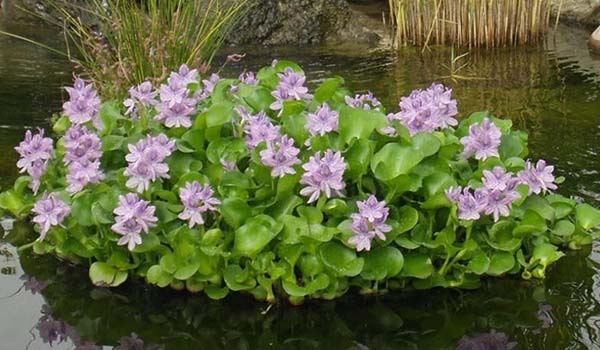

If you decide to breed eichornia in an outdoor pond, take care to create conditions as close as possible to the natural environment. The most important thing for a flower is warm water, rich in organic matter, minerals, vitamins. It is recommended to fertilize the water with compost or humus before planting. The pond does not require preliminary cleansing, since the water hyacinth itself is able to decompose harmful substances into their constituent parts and get rid of them.
If there is a choice, it is recommended to choose a pond with slightly alkaline water - but this parameter is not critical. The main thing is the temperature of the reservoir: hyacinth can develop and bloom normally only at a temperature of + 24-30 degrees. It is important that the pond is well lit and not in the shade.
It is recommended to plant a plant in a pond in May-June: the time was chosen so that before winter the hyacinth had time to settle well in the reservoir, to take root.
In aquarium
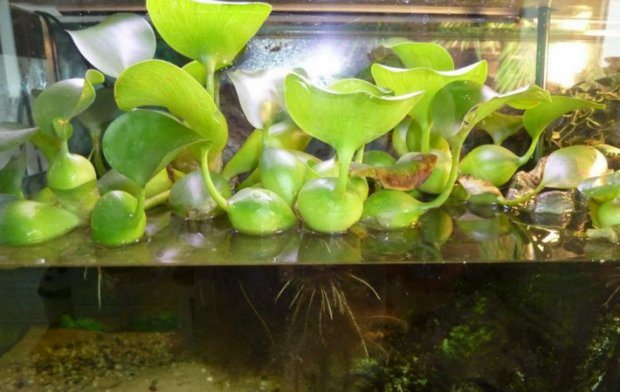

If we talk about room conditions, then in this case it is possible to grow eichornia even in cold regions. In an aquarium, you can easily regulate the temperature of the water - the most important condition for the existence of a flower.
However, there are also disadvantages in this case. The main one is that the aquarium should be of decent size: in a small space, a water hyacinth cannot normally develop. In addition, since there is a limited amount of natural light in the room, it is necessary to take care of artificial lighting in the aquarium.
Eichornia agrotechnology errors
The decorative value of water hyacinth lies in the beauty of its flowers. Straight peduncles are crowned with five to 12 pale purple one-day flowers.
Agricultural mistakes when growing a tropical weed in an ornamental reservoir can lead to:
- Curvature of peduncles.
- Decay of leaves in winter.
- Excessive overgrowth in the pond.
- Water hyacinth loses its leaves in winter.
- Death of a wintering specimen of Eichornia.
- Lack of water hyacinth bloom.
A water hyacinth growing in a pond of stagnant water produces a straight, strong peduncle. In the restless river water a thin pedicel tilted towards the water grows. The leaves of the wintering water hyacinth are easily affected by rot. It is necessary to organize the planting of the plant on a floating raft so that the leaves do not come into contact with the water.It is also extremely important not to cover the terrarium with a lid or to ventilate it daily, avoiding harmful drafts.
Eichornia is able to completely fill the entire surface of the reservoir, since it releases 200-300 shoots during the summer season. Unpretentious culture suppresses flora and upsets the balance of the pond.
It is required to regularly remove excess specimens in order to avoid the expansion of the water hyacinth. In winter, eichornia can lose a few leaves, which is acceptable if there are no other problems. The plant will safely wait for spring, if it is supported by additional lighting and feeding. Instance will quickly regain its attractiveness after returning to open water.
Water hyacinth should not be placed in dark basements for the winter. Tropical plants do not stop photosynthesis throughout the year. Without light, the eichornia will quickly perish. The second common misconception is transplanting a flower into soil or sand. The roots of this plant grow easily into muddy river soil. It should not be forgotten that water hyacinth never grows on the shore.
Eichornia does not bloom in cool summers. Usually, active flowering is observed in July-August, when the weather is hot. Water hyacinth pleases with flowers at an air temperature of at least +25 ° C. Experienced flower growers recommend purchasing eichornia seedlings from local gardeners. In this case, there is a guarantee to obtain accurate information about the flowering of water hyacinths in a given area.
Eichornia or water hyacinth is an aquatic plant for a pond, native to the tropics. It is successfully grown in our conditions, in reservoirs and ponds, despite its tropical origin. Moreover, thanks to the harsh winters, the water hyacinth got rid of some of its shortcomings!
7 factors for successful winter storage in an aquarium + 3 other storage methods, and features of summer care, it's not so simple with water hyacinth!
Water hyacinth (Eichornia) - description
Eichornia leaves are collected in a rosette. At the base of the leaf there is a specific bulge, a distinctive feature of the plant, inside which there is a porous tissue, thanks to which the plant is kept afloat. According to the observations of gardeners, in calm waters, this compaction becomes less pronounced. The roots are long (up to 0.5 m), completely submerged in water.
The flower is extraordinarily beautiful, its shape resembles a hyacinth, pink, blue or purple. Flowers appear in late summer.
Water hyacinth is capable of absorbing hazardous and harmful elements dissolved in water:
- insecticides,
- phenols,
- phosphates,
- cadmium,
- nickel
- silver.
In warm regions, at home, eichornia multiplies rapidly and soon covers the surface of reservoirs with a dense carpet. Due to the dense vegetation layer, the oxygen regime of the reservoir deteriorates sharply, which leads to the death of other plants, the reservoir itself acquires an extremely unpleasant odor.
In our conditions with cold winters, eichornia does not have time to fill the water surface during the warm season enough to become a problem. And for the winter you have to hide it in a warm room. It seems to be an unpretentious plant, but both in the summer and during the winter water hyacinth shows its character, knowing its requirements, you will easily get along with it!
Landing
We will find out how the planting of a water hyacinth is carried out.
The first step is to separate the outlet from the mother plant, the daughter process. The separated part is placed in a pond with warm water - it can also be an ordinary small aquarium. Provide the plant with good nutrition and light. If the flower is bad, he will demonstrate this by the death of the foliage. Take immediate action by increasing daylight hours or temperatures by feeding.
In favorable conditions, young Eichornia develops very quickly.It grows roots, and the plant soon acquires its own foliage rosette.
When growing further in the aquarium, the usual routine care follows. If you plan to transplant the hyacinth outside into a pond, then you should do this at the beginning of summer, when the weather is warm. The transfer is quite simple: the hyacinth is simply transferred to the surface of the pond and no longer touched.
Application in landscape design
That is why eichornia is beautiful to be widely used to create gorgeous landscapes. This reminder of warm America and the tropics is common in landscape design all over the world. The delicate color and cute hyacinth leaves in the pond are a great addition to the garden. In the aquarium, the plant will turn into a colorful spot that will harmoniously combine with bright fish and shells. The main thing is to constantly monitor this inhabitant of your reservoir and limit its growth so that there is not too much hyacinth. Let the excellent eichornia become a useful plant and please your eye!
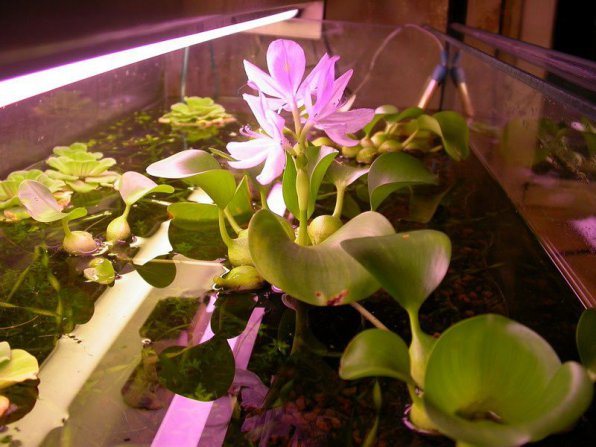

Eichornia excellent or water hyacinth photo
Distribution - South America.
Eichornia excellent or water hyacinth (Eichhornia crassipes) - the plant is a rosette of glossy, bright green leaves of the original shape, having an air chamber at the base. Thanks to her, the plant keeps afloat. It owes its name to a beautiful inflorescence with a strong pleasant smell.
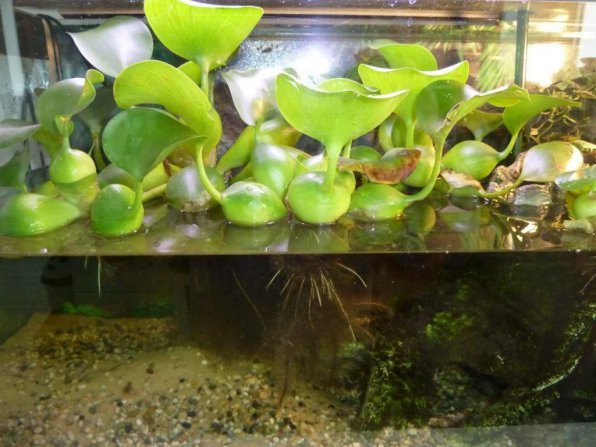

Eichornia excellent or water hyacinth photo
The plant is able to extract nitrogenous compounds and other metabolic products of fish from water.
Water parameters for keeping eichornia excellent or water hyacinth: temperature 26-32 ° С. The aquarium should have a humid air chamber with a height of at least 20 cm, tightly closed. Hardness up to 6 °, pH 6-6.8.
The plant loves bright lighting from 70 lm / l. Daylight hours 12-14 hours.
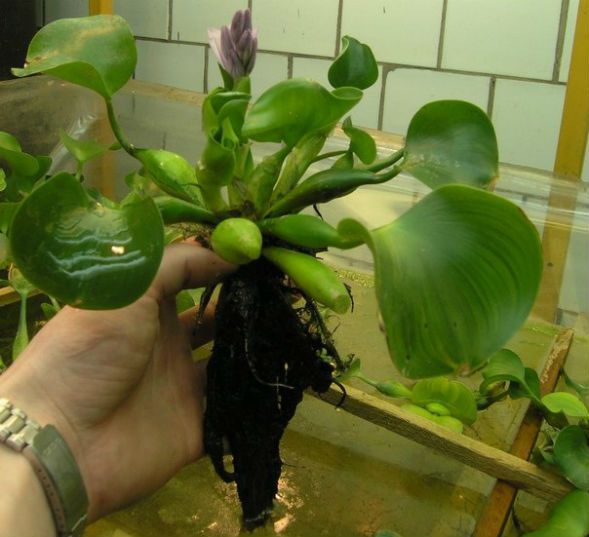

Eichornia reproduces easily, by the formation of daughter plants at the ends of the lateral shoots. Young plants, after they have 3-4 leaves, can be separated from the mother.
The plant is more suitable for keeping in a pond, but as you can see in an aquarium it is possible. The main thing is light and humidity.
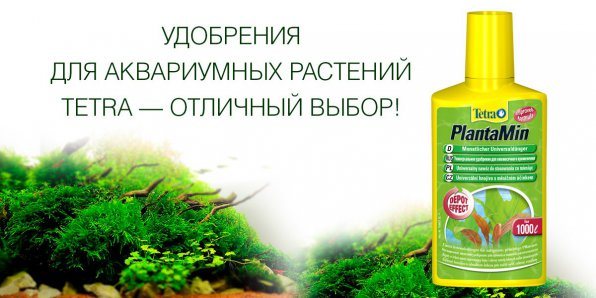

All of the above is just the fruit of observing this type of aquarium plant and collecting various information from owners and breeders. We would like to share with visitors not only information, but also living emotions, allowing you to more fully and subtly penetrate the world of aquarium hobby. Register on, participate in discussions on the forum, create profile topics where you will talk about your aquatic organisms in the first person and firsthand, describe their content features, share with us your successes and joys, share experiences and learn from the experience of others. We are interested in every part of your experience, every second of your joy, every realization of a mistake, which makes it possible for your comrades to avoid the same mistake. The more we are, the more pure and transparent droplets of goodness in the life and life of our seven-billion-dollar society.
Eichornia excellent video review
How to care
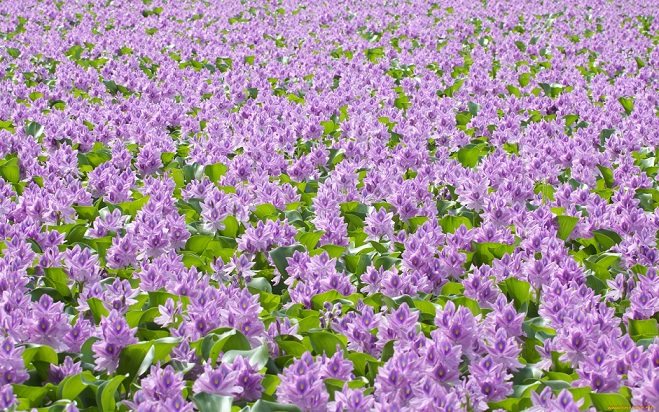

Let's find out what care the eichornia needs when growing it in a pond or aquarium.
Temperature
It is very important, as already mentioned, to maintain the optimum temperature of water and air. If it drops below +24 degrees, it is fraught with loss of health for the plant, the ability to bloom and develop. Note that the water hyacinth can survive at a temperature of + 10-20 degrees, however, there will be no flowering in this case.
Lighting
For normal life, a water hyacinth needs a lot of light: the duration of daylight hours should be at least 14 hours.
Pruning
Do not forget about pruning the plant, as hyacinth multiplies quite quickly. It is especially important to remember this procedure when growing in an aquarium where fish also live. If the flower grows strongly, there will simply be no room for the fish.
To prevent strong overgrowth, it is recommended to immediately remove the resulting horizontal shoots. Remember that the trimming procedure is performed only with gloves, since the juice of water hyacinth has poisonous properties, it can cause skin irritation and allergic reactions.
In the summer, pruning of dead leaf stalks is also required, since otherwise the reservoir will quickly become clogged. It is easy to understand which of the petioles are dead: they stand out against the background of the main foliage with a dark color and lethargy. Also thin out the plantings from time to time, since the eichornia grows irresistibly in favorable conditions.
Top dressing
Water hyacinth will develop well and bloom only in “fertile” water, saturated with nutrients. To fertilize the water, it is recommended to regularly add the following substances to it:
- compost;
- mullein;
- complex minerals for aquarium plants;
- silt
Add some superphosphate to the water when you move the plant to a new pond.
Planting and caring for flowers
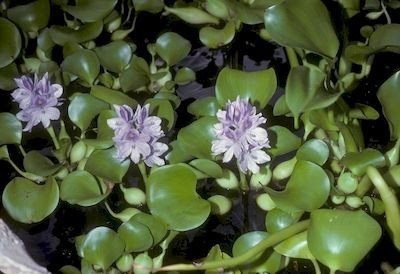

When planting a plant in a reservoir, it is necessary to take into account that the water is fortified with a large amount of organic matter.
Professional flower growers recommend adding river silt, humus, mullein, compost, and complex commercial fertilizing to the water. Planting is done in late spring - early summer, when the temperature becomes stable.
Important! The active growth of rosettes depends on the amount of micronutrients in the water.
Pruning
During the entire summer period, special care for this plant is not required. Periodically, black old leaf petioles are cut from it. They can be easily broken off from the mother flower without using force.
Important! You cannot plant Eichornia together with water lilies. Due to the strong growth of the Water Hyacinth, the water lilies will not have enough space and they may die.
Reproduction
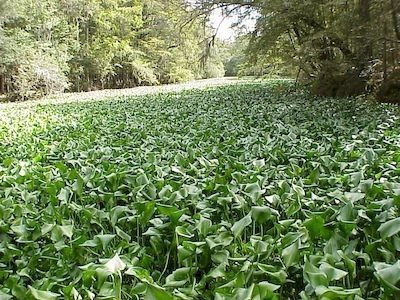

For its amazing ability to reproduce quickly, professional growers call this plant a "double champion". The procedure is similar to propagation of strawberries.
The flower forms daughter processes. In 30 days, the mother plant produces more than 100 new specimens of Eichornia. Therefore, it is generally accepted that reproduction occurs exponentially.
The increase in mass in this representative of the flora occurs with a decrease in daylight hours. Also, the flower is propagated by seeds. But for the seeds to fully ripen, a stable temperature of over 36 ° C is required. Therefore, in most regions of the Russian Federation, this breeding method is impossible.
After flowering, the fruit with seeds bursts and the seeds fall into the water. At high temperatures, the seeds begin to grow vigorously. With a lack of heat, they rot.
Important! It is necessary to know that when growing Eichornia in decorative reservoirs with living flora, excessive reproduction of this representative of the flora leads to a change in the incoming light. The oxygen level in the water changes, which leads to the death of living beings. Therefore, artificial aeration of water should be provided for the flora.
Temperature
The active growth of the plant occurs at a temperature of 25-27 ° C. The flowering period begins at temperatures above 28 ° C. If the temperature drops below 22 ° C, then flowering stops. This temperature holds up well in the USA and Asia.
It is difficult to achieve full flowering in the northern and central parts of the Russian Federation. Therefore, the plant is recommended for growing in the south of the Russian Federation, Belarus and Ukraine. The closer the plant is to the south, the more abundantly it blooms.
Lighting
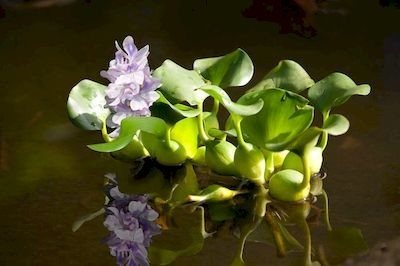

The plant needs over 14 hours of daylight. With a lack of sun, the flower will begin to wither and shed its leaves.
Therefore, if it is not possible to provide such a lighting mode, the flower is illuminated artificially. Fluorescent lamps are perfect for this.
How to keep in winter?
After the end of the summer period and the temperature has dropped, it is recommended to transfer this representative of the flora to a warm, windless, well-lit room. It is recommended to use basins or large aquariums as containers for wintering.
To fill the container, you must use water from the reservoir where the plant was located. River silt is added to it, thanks to which the plant quickly adapts to new conditions and takes root easily. For a full wintering, the plant must provide:
- Stable temperature over 20 ° C.
- Water temperature 20 ° C.
- Artificial and daylight illumination for 13-15 hours a day.
- Oxygen supply.
- Elimination of drafts and direct wind.
- In case of evaporation, add water to the container.
During wintering, containers with a plant are placed as far as possible from heating appliances. The air must be humidified with water from a spray. It is important to ensure that this representative of the flora is constantly in the water. It is forbidden to cover containers with cellophane or other objects. Otherwise, the plant will have nothing to breathe, and it will die.
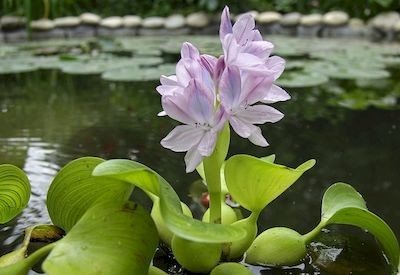

It is forbidden to install the plant in a dark cellar, closet and basement. To prevent the leaves from rotting, while in the water, the plant is installed on a ring float.
With it, the root system of the flower will be completely submerged in water. And the leaves will be on the surface, not in contact with water.
Some growers recommend keeping Eichornia in a moist substrate or sea sand. In this case, you should not keep the plant in metal containers, since with constant contact with water, they begin to rust heavily.
In the video, the expert tells how the Water Hyacinth winters best.
Wintering
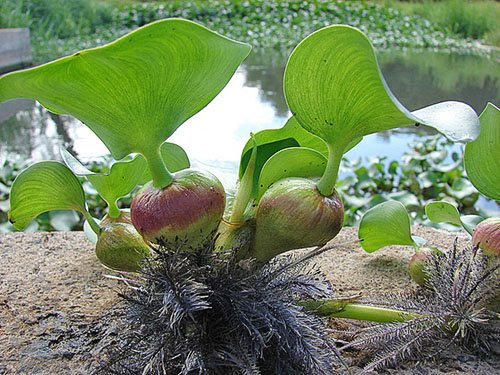

The main difficulty in growing water hyacinth in a pond is our Russian winter - a tropical flower is not able to survive it in natural conditions. A severe cold snap is a huge stress for the plant, so the first task of the grower at this time is to help survive the harsh times.
When the temperature drops below +15 degrees, the hyacinth must be removed from the pond. Try to prevent the plant from freezing, as in this case the eichornia may die. It is most convenient to catch a flower from a reservoir with a net.
Place it in a large container filled with water from the same pond and move it indoors. Lighting in winter should be kept at a minimum of 10 light hours.
It is important to monitor the temperature of the water in the container in winter, maintaining it at +20 degrees. In addition, the flower must be provided with the necessary amount of fresh air, while being protected from drafts.
Don't forget to fertilize your plant to help it winter safely. It is necessary to place the container at a distance from the heating batteries, since the eichornia does not tolerate dry air well. You cannot cover the container from above, it is also forbidden to remove the hyacinth from the aquatic environment for a long time.
Important: if during the winter period you notice that the flower has begun to lose its foliage, it means that it has little light. In this case, hang an extra lamp over the container.
Breeding features
In nature, the flower multiplies without any difficulty, easily and quickly. But even in artificial conditions, reproduction is also not a very difficult procedure. There are opinions that this process is very similar to the reproduction of garden strawberries with a mustache: water hyacinth also multiplies with the help of daughter processes.
Under favorable conditions in summer, the water hyacinth increases its population at an unprecedented rate, forming up to 100 new young plants per month. You can help him by plucking a daughter process from the mother bush in time and transplanting the latter to another place.
If you don't have your own hyacinths yet, seed reproduction is also possible.But this procedure is fraught with difficulties, the main of which is ensuring the seeds are kept for a long time at a temperature of +35 degrees.
Diseases and pests
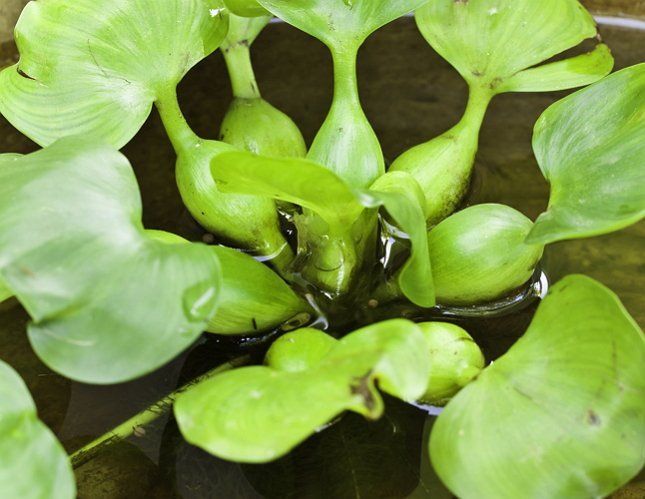

This plant is distinguished by good health and its diseases are solely the result of improper maintenance or care. As for pests, the danger for hyacinth is mainly the weevil beetle. But even this pest will not be able to cause any tangible harm to the plant.
Pay attention to the appearance of the plant. If suspicious dark spots appear on the leaves, this may indicate a hyacinth cold due to drafts or lack of fresh air.
If the spots have multiplied and acquired a dark brown tint, this symptom may indicate root rot. Putrefactive processes can be prevented by placing the plants on special float rings that will keep the hyacinth above the water surface.
The plant does not tolerate drafts and gusts of wind. Therefore, in order to exclude such a negative impact, it is recommended to plant some bushes or tall plants tightly along the banks of the artificial pond.
So, we got acquainted with an amazing plant - water hyacinth. Of course, growing it in our cold climate is fraught with difficulties - after all, the flower has a tropical origin and is very thermophilic. However, if you can meet all the conditions, then you will get a wonderful decorative decoration of a pond or aquarium.

